Recent technical developments in F1, concerning the design and adoption of the new D.A.S. system by Mercedes, have stimulated several discussions aimed at assessing the real benefits of this device.
Apart from understanding the specific mechanical layout of D.A.S., what we are aware of, and noted from the TV images from Barcelona pre-season test, is that the system is able to allow the driver to vary the vehicle front toe angle, passing from a «conventional» configuration, characterized by an open toe, typical in motorsport for the benefits it provides in curve management, to a «less open» one, that could provide advantages in terms of drag reduction and tires management. Regarding this last topic, our technical team was focused, in the last days, on the development of a straightforward tire dynamic simulation, useful to get preliminary info, to understand and quantify the effects due to D.A.S. on tires thermal behaviour.
In particular, a reference racing vehicle, with similar characteristics to a F1 car, has been modelled in VI-grade CarRealTime environment, working in co-simulation with MegaRide tire models thermoRIDE and adheRIDE. The first one is a real-time physical tire thermal model, used to get the local temperature and energy distribution along tire thickness and longitudinal/lateral directions. The second one is a new Pacejka’s MF formulation, able to let tire forces vary, accounting for temperature, wear, road roughness and compound viscoelasticity.
Work Description
The reference vehicle, in the developed simulation, will run on a counter-clockwise reference handling track, activating in each lap a «virtual» D.A.S. system in one of the two straight lines, highlighted in red in the figure.
The D.A.S. has been modelled in a preliminary approach, with an analytic law, hypothesizing a reduction of absolute value of the toe angle, in the red straight.

The vehicle performs laps on the reference track, in two different cases (with and without D.A.S.), minimizing the lap time thanks to CarRealTime MaxPerformance algorithm, with thermoRIDE and adheRIDE models running in co-simulation thanks to specific APIs developed both for Matlab/Simulink environment and native C applications (commonly used on driving simulators).
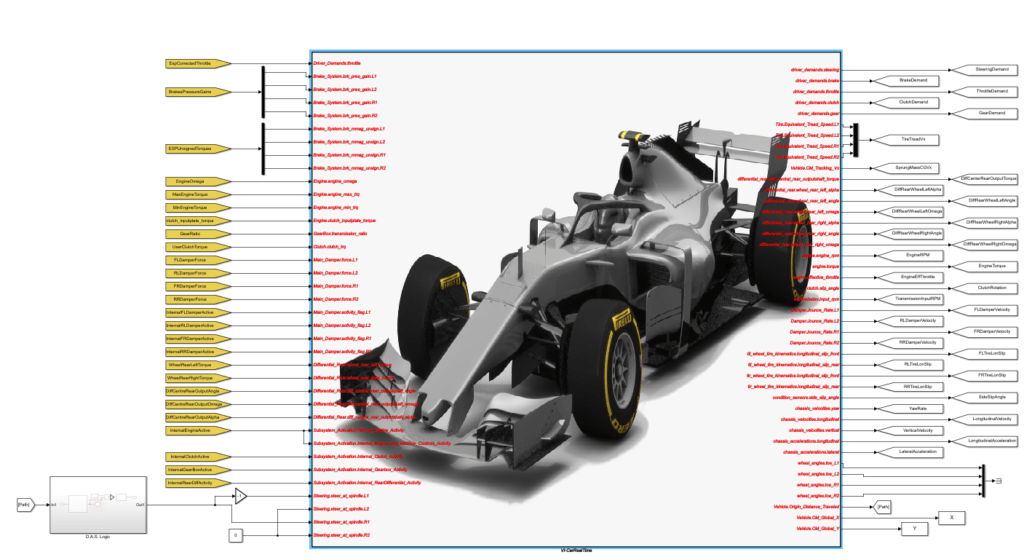
The results showed in the following plots are referred to the front tires thermal behaviour, with particular reference to the effects observable at tread external surface, and in the tread core and bulk layers, not directly measurable in outdoor test, and closely linked to the grip and stiffness phenomena on which the drivers’ efforts are focused in performance optimization strategies.
Results Analysis
The tread ribs are numbered, per each tire, as shown in the following image.
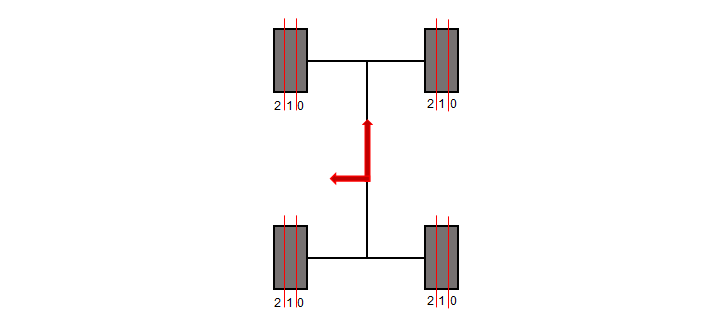
Tires start the simulation at a global temperature of 65°C, while air temperature has been set at 15°C, and road temperature at 15°C. Starting inflation pressure is hypothesized at 1.3 bar for the four tires.
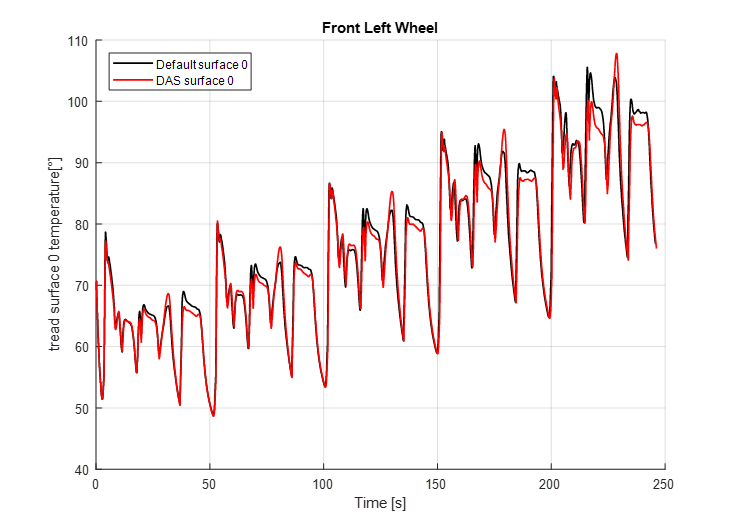
In the first plot, the comparison between tread external temperature (in particular, on rib 0 for front left wheel) in the two cases is observable. Due to the reduced friction power (the product between the tangential force and the sliding speed), linked to the decrease of tire slip angle in the D.A.S. activation phases, the simulation with the device leads to a lower thermal level.
Such result can be interpreted as an advantage in case tire dynamic evolution could lead to an overheating condition, typical of highly stressing tracks.
The availability of D.A.S. represents a further “tuning element” that can give the driver the possibility to directly manage the energetic flux from the contact patch to the whole tire, optimizing the grip balance.
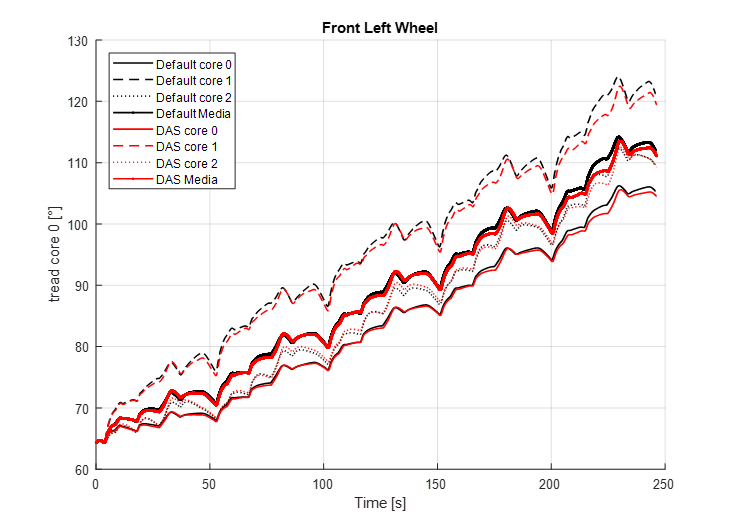
In the second plot, referred to the tread inner layer, called “tread core”, a similar result is showed. In particular, the thick lines represent the average temperatures among three tread ribs, highlighting again a “sweeter” management of tires, reaching slightly lower temperatures.
This plot highlights a fundamental aspect in tire dynamics. Tire grip does not evolve in correlation with the “highly dynamic” external tread temperature, but with the temperature that the tread reaches at its core layer. A temperature that cannot obviously be directly measured, but that a tire thermal model can provide, together with several further info, like inner air temperature and pressure, sidewall temperature, etc.
As well, also tire stiffness variations, and in particular cornering stiffness one, are directly correlated to tire tread core and bulk temperatures, that for the expressed reasons need to be managed in the proper way for the whole racing event.
For further details, some papers highly detailed on thermoRIDE model, are reported in bibliography, at the end of the text.
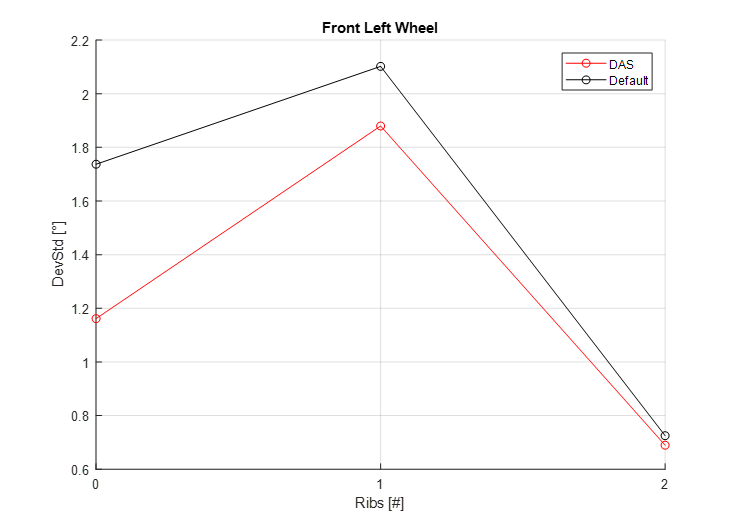
Finally, some other worth mentioning results are reported in the third figure.
The standard deviation of the external temperature of the three tread core ribs, respect to their average value previously reported, is plotted for the D.A.S.-ON and D.A.S.-OFF scenarios.
D.A.S.-ON simulations show lower levels of spatial standard deviation. It means that tires have a more homogeneous temperature distribution.
High differences among ribs energies (and consequently temperatures) affect the undesired phenomena linked to irregular wear (local graining, mechanical degradation, …). A device able to let the whole tread work reducing the “thermal shocks” could became a real advantage in the optimal management of a long race event, guaranteeing good handling and durability.
Of course, the presented case study has to be intended as a simple and preliminary overview on the thermal effects linked to the D.A.S. system. Further detailed analysis will be carried out with our motorsport partners, with a precise and reliable quantification of the data, and a detailed modelling of vehicle characteristics and tire thermodynamics.
Activity carried out by Giuseppe Tranquillo – Vehicle Dynamics Engineer